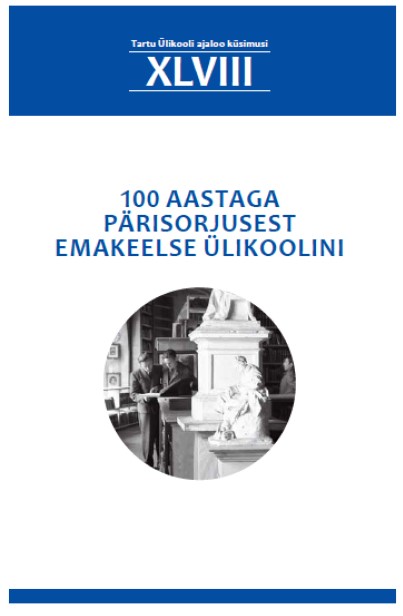"Rootslasena oli ta meile võõram." Kunstiajaloo professori Helge Kjellini õpinguaastad ja kujunemine enne Tartut
"As a Swede he was stranger to us." Art historian Helge Kjellin as a person, a professor and a scholar
DOI:
https://doi.org/10.15157/tyak.v48i48.16889Abstract
In 1921, the assistant professor of art history at the Swedish University
of Lund, Helge Kjellin (1885-1984), was invited to the chair
of art history at the University of Tartu in Estonia. He arrived in
Tartu in January 1922 and left the chair in June 1924. It would seem
that his stay in Tartu was relatively short, however, the majority
of foreign professors invited to the reorganised Estonian university
during and just after the War of Independence, did not stay here for
much longer.
Kjellin had altogether about 100 art history students in Tartu
during this period. Two of them have described their personal experience
and relationship to the professor in their published memories.
Elsbet Parek was quite critical and said that Kjellin seemed to look
down on the Estonian students and considered them “too primitive
to study art history.” In her opinion, the professor stressed his higher
status by all possible means, for example travelling in a ship cabin
on their expedition to the churches on the Estonian island Saaremaa
while students had to travel on the deck. E. Parek concluded that the
professor did not manage to develop a friendly relationship with his
students. In addition he was always unsatisfied with the university
council for giving scarce funds for the development of his chair. E.
Parek’s sentence “As a Swede he was stranger to us” should be continued,
because she was actually comparing Kjellin with the Finnish
professor of archaeology – Aarne Michael Tallgren. The latter was
much appreciated by the students and very friendly with them and
he also had good relationships with the university council.
Kjellin’s negative image among his students might have been one
of the reasons for neglecting his work by Estonian art historians during
the following decades. There are only a few articles written about
him and his work in Estonia. However, much can be found out from
the curriculum vitae he sent to the University of Tartu in 1920 and if the few biographic articles in Swedish and the materials in his personal
archives are added the following can be summarised.
Kjellin was born in a big middle-class family in Värmland, Sweden.
The family moved to Stockholm where he went to a prestigious
boys’ gymnasium that prepared students for higher education. He
was interested in history and literature and even made his debut as
a novelist before deciding to study literature at Uppsala University.
However, meeting the art historian Johnny Roosval, might have been
the reason to graduate as an art historian instead. Similarly to his
professor Kjellin also took to the study of medieval church architecture.
After graduation from Uppsala University in 1913 Kjellin started
practicing art history at the National Museum of History in Stockholm
where he managed to impress his supervisor and the director
of the museum. After diligent work for the Hudiksvall church art
exhibition, in 1914 he was sent to Malmö museum to reorganise the
exposition. One thing was followed by another and he was asked to
participate in the preparation of the Skåne church art exhibition. The
curator of the exhibition was the director of the history museum in
Lund - Otto Rydbeck who worked with the professor of literary and
art history in Lund University - Ewert Wrangel. As a result Kjellin
continued his academic studies in Lund.
Kjellin was promoted Doctor of Philosophy with a thesis on the
oeuvre of the 19th century Swedish artist Uno Troili. Kjellin seems
to have aspired towards a cultural historical treatment of the subject,
but as he delved into biographical minutiae of peripheral importance,
his thesis was criticised by some prominent Swedish art historians
for not being “scientific” enough. During this time period, however,
art history was striving for academic independence in Swedish universities,
and the question of making art history more “scientific” was
very important.
Before participating in the competition for the chair of art history
in Estonia, Kjellin became assistant professor of art history at the
Lund University. He not only held lectures and seminars primarily
on medieval art history, but also did most of his research on the same
topic. At the same time he was engaged with organising exhibitions
at the university art museum. His experience of the museum work was probably the main reason for inviting him to Estonia. However,
in Estonia he also continued his research on medieval churches. He
could be considered the first art historian in Estonia who started to
use modern methods to study the building history of medieval architecture.
During the few years in Tartu he established the academic
education of professional art historians in Estonia.

